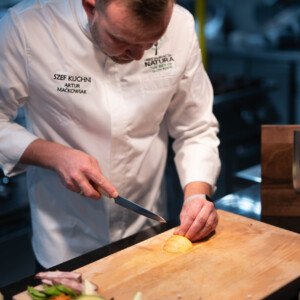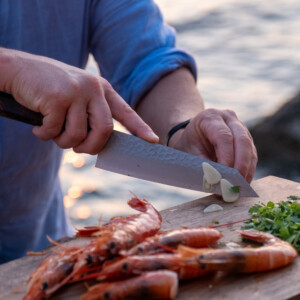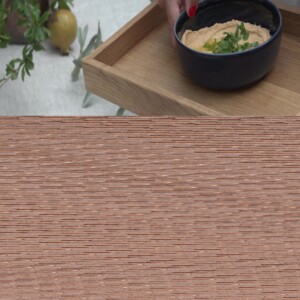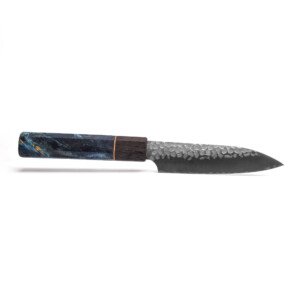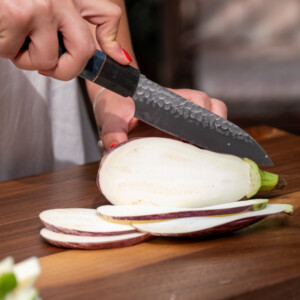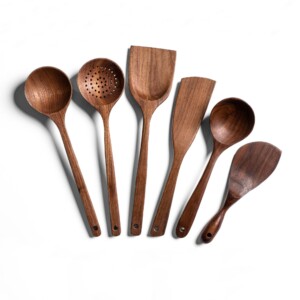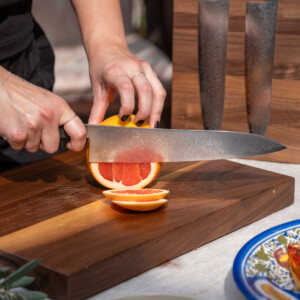As a Japanese knife store run by foodies who love to cook and value quality, everlasting products, we understand the importance of having the right tools in the kitchen. And we need to tell you that one of our must haves and the most versatile knives in any kitchen is the Santoku knife.
Originating in Japan, the word “Santoku” literally means “three virtues” or “three uses.” This knife is designed to perform three main tasks in the kitchen – slicing, dicing, and mincing. The blade of a Santoku knife is typically shorter and wider than a typical chef’s knife or Gyuto, and features a straighter edge.
The Santoku knife’s shorter length and straighter edge make it easier to handle, especially for people with smaller hands or those who prefer a lighter weight knife. This makes it a popular choice for home cooks and professionals alike. It is an excellent all-purpose knife that can be used to prepare a variety of ingredients including meat, fish, vegetables, and fruits.
The Santoku knife’s design allows for a swift chopping motion with less force, making it easier to cut through ingredients without crushing or tearing them. This is especially useful when preparing delicate foods like herbs or sushi. The wide blade of the Santoku also makes it ideal for transferring ingredients from the cutting board to the pan or plate, without the need for a separate tool.
How does Gyuto and Santoku differ?

While the Santoku knife and the Gyuto share some similarities, there are a few key differences that set them apart. The Gyuto has a longer and thinner blade, making it ideal for slicing through large cuts of meat or fish. The blade of a Gyuto is also curved, allowing for a rocking motion when cutting. The Santoku, on the other hand, is shorter and wider, making it easier to control and handle. The straight edge of the Santoku makes it more suitable for push-pull chopping, which can be particularly effective for cutting through dense vegetables or fruits.
In terms of versatility, the Santoku and the Gyuto are both excellent knives that can perform a variety of tasks in the kitchen. However, the Santoku’s shorter length and straighter edge make it a more popular choice for home cooks and those who prefer a lighter weight knife.
Will Santoku be a good choice for me?
Another factor to consider when choosing a knife is the size and strength of the person using it. As mentioned earlier, the Santoku’s shorter blade and lighter weight make it an excellent choice for those with smaller hands or less upper body strength. This makes it a particularly popular choice for women. However, it’s important to note that the size of the blade should ultimately be determined by the size of the ingredients being prepared.
When selecting a Santoku knife, there are a few key features to look for. The blade should be made of high-quality steel, such as VG10 or AUS-10, which are both known for their sharpness and durability. The handle should also be comfortable to grip, and made from a durable material like wood or resin. It’s also important to consider the weight of the knife, as a heavier knife may cause fatigue over time.
At Oishya, we believe that investing in high-quality kitchen tools is essential for any home cook or professional chef. Our selection of Santoku knives are all handcrafted in Japan using traditional techniques, ensuring that each knife is of the highest quality. We offer a range of options to suit every budget and style preference, from classic wooden handles to modern resin options.
In addition to our selection of knives, we also offer sharpening services to ensure that your knives remain sharp and effective over time. We believe that a good knife is an investment that should last a lifetime, and we are committed to providing our customers with the best products and services possible.
In conclusion, the Santoku knife is a versatile and essential tool in any kitchen, with its ability to slice, dice, and mince a variety of ingredients with ease. Its shorter length and straighter edge make it easier to control and handle, and its popularity among home cooks and professionals alike is a testament to its effectiveness. Whether you are preparing a simple meal at home or creating a complex dish in a professional kitchen, a high-quality Santoku knife is a must-have tool.
What's the western version of the Japanese Santoku knife?
The western version of the Japanese Santoku is the chef’s knife, also known as the French knife. The chef’s knife is a multi-purpose kitchen knife that is used for a variety of tasks including chopping, slicing, and dicing. It typically has a longer and thinner blade than a Santoku, and features a curved edge that allows for a rocking motion when cutting. While the chef’s knife and the Santoku share some similarities in terms of versatility, their differences in blade shape and design can make them better suited for different tasks and personal preferences.



